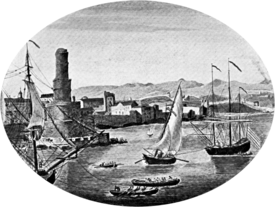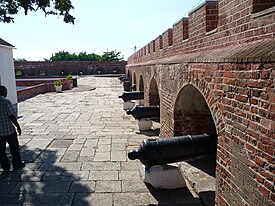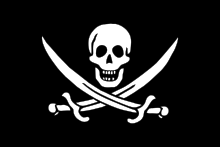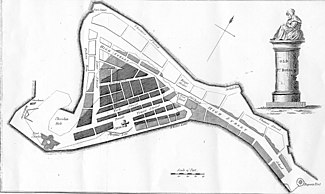Port Royal
Port Royal | |
|---|---|
City | |
 An illustration of pre-1692 Port Royal | |
| Coordinates:17°56′15″N76°50′28″W/ 17.93750°N 76.84111°W | |
| Country | Jamaica |
| Parish | Kingston |
| Founded | 1494 |
| Destroyed | 1692 |
Port Royalis atownlocated at the end of thePalisadoes,at the mouth ofKingston Harbour,in southeasternJamaica.Founded in 1494 by theSpanish,it was once the largest and most prosperous city in theCaribbean,functioning as the centre of shipping and commerce in the Caribbean Sea by the latter half of the 17th century.[1]It was destroyed by anearthquake on 7 June 1692and its accompanyingtsunami,leading to the establishment ofKingston,which is now the largest city in Jamaica. Severe hurricanes have regularly damaged the area. Another severeearthquake occurred in 1907.
Port Royal became home port to English and Dutch government sponsoredprivateerswho were encouraged to attackSpanishvessels, at a time when many European nations were reluctant to attack the powerful Spanish fleet directly. As a port city, it was notorious for its gaudy displays of wealth and loose morals, with the privateer crews spending their treasure in the manytaverns,gambling houses and brothels which catered for the sailors. When the British and Dutch governments officially abandoned the practice of issuingletters of marqueto privateers against the Spanish treasure fleets and possessions in South America in the later 16th century, many of the crews turnedpirateto allow themselves to maintain their plundering illegally. Port Royal effectively became a pirate republic, and they continued to use the city as their main base during the 17th century. Pirates from around the world congregated at Port Royal, coming from waters as far away asMadagascar.The town became notorious in folklore as 'the wickedest city on Earth'.
After the 1692 disaster, Port Royal's commercial role was steadily taken over by the rapidly growing nearby town (and later, city) of Kingston. Plans were developed in 1999 to redevelop the small fishing town as a heritage tourism destination to serve cruise ships. The plan was to capitalize on Port Royal's unique and fascinating heritage, with archaeological findings from pre-colonial and privateering years as the basis of possible attractions.[1]
Climate
[edit]Port Royal has atropical savanna climate(Köppen climate classificationAw) with a short dry season from January to April and a lengthy wet season from May to October. Temperatures remain steady throughout the year with the dry season being slightly cooler and range from 25.5 °C (77.9 °F) in January to 27.7 °C (81.9 °F) in May. The average annual precipitation is 1,345 millimetres (53 in).[2]
History
[edit]
TheTainohistoric indigenous people of the Caribbean occupied this area for centuries before European settlement. They used the area, which they calledCaguayorCaguaya,[3]during their fishing expeditions. Although it is not known whether they ever settled at the spot, they did inhabit other parts of Jamaica.[4]
Colonisation
[edit]The Spanish first landed in Jamaica in 1494 under the leadership ofChristopher Columbus,leading to the destruction of the Taino population. Permanent settlement occurred whenJuan de Esquivelbrought a group of settlers in 1509. They came in search of new lands and valuable resources, like gold and silver. Instead they began to cultivate and process the sugar cane. Much like the Taino before them, the Spanish did not appear to have much use for the Port Royal area. They did, however, retain its Taino name.[3]Spain kept control of Jamaica mostly so that it could prevent other countries from gaining access to the island, which was strategically situated within thetrade routesof the Caribbean. Spain maintained control over the island for 146 years, until the English took control following their invasion of 1655.
The town was captured by England in 1655 during theinvasion of Jamaica.[4][5]By 1659 two hundred houses, shops and warehouses had been built around the fort; by 1692 five forts defended the port.[6]The English initially called the placeCagwaybut soon renamed it Port Royal.[3]For much of the period between the English conquest and the 1692earthquake,Port Royal served as the unofficial capital of Jamaica, whileSpanish Townremained the official capital. In 1872 the government designatedKingston,the largest city, as the capital.[6]
Privateering
[edit]
Port Royal provided asafe harbourinitially for privateers and subsequently forpiratesplying theshipping lanesto and fromSpainandPanama.Buccaneersfound Port Royal appealing for several reasons. Its proximity totrade routesallowed them easy access to prey, but the most important advantage was the port's proximity to several of the only safe passages orstraitsgiving access to theSpanish Mainfrom the Atlantic.[6]The harbour was large enough to accommodate their ships and the shallow waters provided a place tocareenand repair these vessels with no difficulty. It was also ideally situated for launching raids on Spanish settlements. From Port Royal,Christopher Myngssacked CampecheandHenry Morganattacked Panama,Portobello,andMaracaibo.Additionally, buccaneersRoche Brasiliano,John DavisandEdward Mansveltused Port Royal as a base of operations.
In 1657, as a solution to his defence concerns, GovernorEdward D'Oyleyinvited theBrethren of the Coastto come to Port Royal and make it their home port. The Brethren was a group of pirates descended from cattle-huntingboucaniers(later anglicized to buccaneers), who had turned to piracy after being robbed by the Spanish (and subsequently thrown out of Hispaniola).[5]These pirates concentrated their attacks on Spanish shipping, whose interests were considered the major threat to the town.
The Englishprivateerswere givenletters of marqueby Jamaica's governor. Around the same time that pirates were invited to Port Royal, England launched a series of attacks against Spanish shipping vessels and coastal towns. By sending the newly appointed privateers after Spanish ships and settlements, England had successfully set up a system of defence for Port Royal. Spain was forced to continually defend their possessions from attack, providing them with no opportunity and no means with which to attempt to retake the land.[5]
Spain was unable to retake the island and, due to the privateers, could no longer regularly provide their colonies in the New World with manufactured goods. The progressive irregularity of annual Spanish fleets, combined with an increasing demand by colonies for manufactured goods, stimulated the growth of Port Royal. Merchants and privateers worked together in what is now referred to as "forced trade." Merchants would sponsor trading endeavors with the Spanish, while also sponsoring privateers to attack Spanish ships and rob Spanish coastal towns.[5]While the merchants most certainly had the upper hand, the privateers were an integral part of the operation.
Nuala Zahedieh,a lecturer at theUniversity of Edinburgh,wrote the quote: "Both opponents and advocates of so-called 'forced trade' declared the town's fortune had the dubious distinction of being founded entirely on the servicing of the privateers' needs and highly lucrative trade in prize commodities.".[7]"A report that the 300 men who accompaniedHenry Morganto Portobello in 1668 returned to the town with a prize to spend of at least £60 each (two or three times the usual annual plantation wage) leaves little doubt that they were right ".[7]
The forced trade became almost a way of life in Port Royal. Michael Pawson and David Busseret wrote "...one way or the other nearly all the propertied inhabitants of Port Royal seem to have an interest in privateering."[8]Forced trade was rapidly making Port Royal one of the wealthiest communities in the English territories of North America, far surpassing any profit made from the production of sugar cane. Zahedieh wrote, "The Portobello raid [in 1668] alone produced plunder worth £75,000, more than seven times the annual value of the island’s sugar exports, which at Port Royal prices did not exceed £10,000 at this time."[7]

Since the English lacked sufficient troops to prevent either the Spanish or French from seizing it, the Jamaican governors eventually turned to the pirates to defend the city.[9]By the 1660s the city had, for some, become apirate utopiaand had gained a reputation as the "Sodomof the New World "[citation needed],where most residents were pirates, cutthroats, orprostitutes.WhenCharles Lesliewrote his history of Jamaica, he included a description of the pirates of Port Royal:
Wine and women drained their wealth to such a degree that [...] some of them became reduced to beggary. They have been known to spend 2 or 3,000pieces of eightin one night; and one gave astrumpet500 to see her naked. They used to buy apipeof wine, place it in the street, and oblige everyone that passed to drink from it.
The taverns of Port Royal were known for their excessive consumption of alcohol such that records even exist of the wild animals of the area partaking in the debauchery. During a passing visit, famous Dutch explorerJan van Riebeeckis said to have described the scenes:
The parrots of Port Royal gather to drink from the large stocks of ale with just as much alacrity as the drunks that frequent the taverns that serve it.
There is even speculation in pirate folklore that the infamousBlackbeard(Edward Teach) met a howler monkey, while at leisure in a Port Royal alehouse, whom he named Jefferson and formed a strong bond with during the expedition to the island ofNew Providence.[citation needed]Recent genealogical research indicates that Blackbeard and his family moved to Jamaica where Edward Thatch Jr. is listed as being a mariner in theRoyal Navyaboard HMSWindsorin 1706.[10]Port Royal benefited from this lively, glamorous infamy and grew to be one of the two largest towns and the most economically important port in theEnglish colonies.At the height of its popularity, the city had onedrinking housefor every 10 residents. In July 1661 alone, 40 new licenses were granted totaverns.During a 20-year period that ended in 1692, nearly 10,000 people lived in Port Royal. In addition to prostitutes and buccaneers, there were fourgoldsmiths,44 tavern keepers, and a variety ofartisansandmerchantswho lived in 2,000 buildings crammed into 51 acres (21 ha) of real estate. 213 ships visited the seaport in 1688. The city's wealth was so great that coins were preferred for payment over the more common system ofbarteringgoods for services.
FollowingHenry Morgan's appointment as lieutenant governor, Port Royal began to change. Pirates were no longer needed to defend the city. The selling ofslavestook on greater importance. Upstanding citizens disliked the reputation the city had acquired. In 1687, Jamaica passed anti-piracy laws. Consequently, instead of being a safe haven for pirates, Port Royal became noted as their place ofexecution.Gallows Point welcomed many to their death, includingCharles VaneandCalico Jack,who were hanged in 1720. About five months later, the famous woman pirateMary Readdied in the Jamaican prison in Port Royal. Two years later, 41 pirates met their death in one month.[11]
The Royal Navy
[edit]
Under British rule theRoyal Navymade use of acareeningwharf at Port Royal and rented a building on the foreshore to serve as a storehouse. From 1675, a resident Naval Officer was appointed to oversee these facilities;[12]however, development was cut short by the 1692 earthquake. After the earthquake, an attempt was made to establish a naval base atPort Antonioinstead, but the climate there proved disagreeable. From 1735, Port Royal once more became the focus of the Admiralty's attention. New wharves and storehouses were built at this time, as well as housing for the officers of the Yard. Over the next thirty years, more facilities were added:cooperages,workshops,sawpits,and accommodation (including a canteen) for the crews of ships being careened there.[13]ARoyal Naval Hospitalwas also established on land a little to the west of the Naval Yard; and by the end of the 18th century a smallVictualling Yardhad been added to the east (prior to this ships had had to go toKingstonand other settlements to take on supplies).[13]
At the start of the 19th century, a significant amount of rebuilding took place in what was by now a substantialRoyal Navy Dockyardserving the fleet in theCaribbean.A sizeable storehouse with a clocktower formed the centrepiece, with a covered way leading from it to the careening wharves. The adjacentPort Admiral's (later Commodore's) House included awatch tower,to counter the threat ofprivateers.The Yard continued to expand to meet the new requirements ofsteam-powered vessels:the victualling wharf became acoaling depotin the 1840s, and twenty years later a small engineering complex was built.[13]The Yard continued to expand through to the beginning of the 20th century, but then (with the Admiralty focusing more and more on thesituation in Europe) the Navy withdrew from its station in Jamaica and the Dockyard closed in 1905. (Nevertheless, the Naval Yard and Hospital remained in Admiralty ownership until after theSecond World War,with part of the Yard being used by theWar Department).[14]
Many of the Dockyard buildings (most of which were of timber construction) were subsequently demolished or destroyed (some in the1907 Kingston earthquake,others byHurricane Charliein 1951).[15]A few remain in place, however, including the Naval Hospital complex, some of the steam engineering buildings and a set of officers' houses.[16]There is also a slipway, completed as late as 1904, which (with its accompanying sheds) was designed for housing and launchingtorpedo boats,stationed there for the Yard's protection. In 2014, it was announced that some of the Historic Naval Hospital buildings would be restored to house a museum as part of a broader Port Royal Heritage Tourism Project.[17]
Earthquake of 1692
[edit]

The town grew rapidly, reaching a population of around 6,500 people and approximately 2,000 dwellings, by 1692. As land on which to build diminished, it became common practice to either fill in areas of water and build new infrastructure on top of it, or simply build buildings taller. Buildings gradually became heavier as the residents adopted the brick-style homes of their native England. Some[who?]urged the population to adopt the low, wooden building style of the previous Spanish inhabitants, but many refused. In the end, all of these separate factors contributed to the impending disaster.


On 7 June 1692, a devastating earthquake hit the city causing most of its northern section to be lost – and with it many of the town's houses and other buildings. Many of the forts were destroyed, as well;Fort Charlessurvived, but Forts James and Carlisle sank into the sea, Fort Rupert became a large region of water, and great damage was done to an area known as Morgan's Line.[4]
Although the earthquake hit the entire island of Jamaica, the citizens of Port Royal were at a greater risk of death due to the perilous sand, falling buildings, and thetsunamithat followed. Though the local authorities tried to remove or sink all of the corpses from the water, they were unsuccessful; some simply got away from them, while others were trapped in places that were inaccessible. Improper housing, a lack of medicine or clean water, and the fact that most of the survivors were homeless led to many people dying of malignant fevers.[18]The earthquake and tsunami killed between 1,000 and 3,000 people combined, nearly half the city's population.[citation needed]Disease ran rampant in the next several months, killing an estimated 2,000 additional people.[19]
The historical Jamaica earthquake of 7 June 1692 can be dated closely not only by date, but by time of day as well. This is documented by recovery from the sea floor in the 1960s of a pocket watch stopped at 11:43 a.m., recording the time of the devastating earthquake.[20][21]
The earthquake caused the sand under Port Royal toliquefyand flow out into Kingston Harbour. The water table was generally only two feet down before the impact, and the town was built on a layer of some 65 feet (20 m) of water-saturated sand. This type of area did not provide a solid foundation on which to build an entire town. Unlike the Spanish before them, the English had decided to settle and develop the small area of land, even while acknowledging that the area was nothing but "hot loose sand".[22]
According to Mulcahy, "[Modern] scientists and underwater archaeologists now believe that the earthquake was a powerful one and that much of the damage at Port Royal resulted from a process known as liquefaction."[22]Liquefaction occurs when earthquakes strike ground that is loose, sandy, and water-saturated, increasing the water pressure and causing the particles to separate from one another and form a sludge resembling quicksand. Eyewitness accounts attested to buildings sliding into the water, but it is likely[clarification needed]some simply sank straight down into the now unstable layer.[22]
Underwater archaeology, some of which can be seen in theNational Geographic ChannelshowWicked Pirate City,reveals the foundations of building underwater, showing there was subsidence, as do comparisons of post-earthquake maps and pre-earthquake maps.
Some attempts were made to rebuild the city, starting with the one third that was not submerged, but these met with mixed success and numerous disasters.[citation needed]An initial attempt at rebuilding was again destroyed in 1703 by fire. Subsequent rebuilding was hampered by severalhurricanesin the first half of the 18th century, includingflooding from the seain 1722, a further fire in 1750, and a major hurricane in 1774, and soon Kingston eclipsed Port Royal in importance. In 1815, what repairs were being undertaken were destroyed in another major fire, while the whole island was severely affected by an epidemic ofcholerain 1850.[clarification needed]
1907 earthquake and recent history
[edit]
A devastating earthquake on 14 January 1907 liquefied the sand spit, destroying nearly all of the rebuilt city, submerging additional portions, and tilting TheGiddy House,an artillery storage room built c. 1880 that is today a minor tourist attraction.[23]
Today, the area is a shadow of its former self with a population of fewer than 2,000 that has little to no commercial or political importance. The area is frequented by tourists, but is in a state of disrepair. The Jamaican government has recently resolved to further develop the area for its historic and tourist value. This is in part a result of abandonment of plans begun in the early 1960s to develop the town as a cruise ship port and destination.[24]The plans stimulated the archaeological explorations on the site which, in turn, led to the suspension of development solely as a port but now included archaeological and other attractions.[6]
In 1981, the Nautical Archaeology Program atTexas A&M Universitybegan a 10-year underwater archaeological investigation of the portion of Port Royal that sank underwater during the 17th century. The program focused on an area that had sunk directly into the sea and suffered very little damage. Due to very low oxygen levels, a large amount of organic material could be recovered. The efforts made by the program have allowed everyday life in the English colonial port city to be reconstructed in great detail.[25]
In 1998, the Port Royal Development Company commissionedarchitectural firmThe Jerde Partnershipto create a master plan for the redevelopment of Port Royal, which was completed in 2000.[26]The focus of the plan is a 17th-century-themed attraction that reflects the city's heritage. It has two anchor areas: Old Port Royal and the King's Royal Naval Dockyard. Old Port Royal features a cruise ship pier extending from a reconstructed Chocolata Hole harbour and Fisher's Row, a group of cafes and shops on the waterfront. The King's Royal Naval Dockyard features a combinationshipbuilding-museum and underwater aquarium withdioramasfor views of the native tropical sealife.[26]The Royal Naval Dockyard also includes the headquarters for theAdmiralof theRoyal Navy.The redevelopment plan also includes afive-star hotel.[27]
Today, Port Royal is known to post-medieval archaeologists as the "City that Sank".[28]Robert Marxconsiders it the most important underwater archaeological site in the western hemisphere,[citation needed]yielding 16th–and-17th-century artifacts and many important treasures from indigenous peoples predating its 1518 founding, some from as far away asGuatemala.Several 17th and early 18th century pirate ships sank within Kingston Harbour and are being carefully harvested, under controlled conditions, by various teams of archaeologists. Other "digs" are staked out along various quarters and streets by different teams.[citation needed]
By 2019, a floating pier where a cruise ship could dock had been built; the first ship arrived on 20 January 2020. Tourists from a few ships (after the effects of theCOVID-19 pandemichave ended) might be beneficial to the town, but "there's still much work to be done if the town will become the 'world-class heritage, environmental and cultural attraction'"according to aBBCTravel report published in September 2020.[29]Another report that month discussed the well-funded Living Heritage Programme, which was seeking "to transform the town into a SMART, safe and secure community with a vibrant local economy, preserved cultural heritage and protected natural environment".[30]
References
[edit]- ^abDavis, Nick (25 July 2012)."Jamaica's 'wickedest city' Port Royal banks on heritage".BBC News.Archivedfrom the original on 29 September 2018.Retrieved21 June2018.
- ^"Climate Summary for Port Royal".Weatherbase.Archivedfrom the original on 7 July 2020.Retrieved30 March2019.
- ^abcHigman, B W; Hudson, B J (2009).Jamaican Place Names(Softcover)(1st ed.). Kingston, Jamaica:University of the West Indies Press.p. 26.ISBN978-976-640-217-4.Archivedfrom the original on 16 July 2020.Retrieved5 January2016.
- ^abcMichael Pawson and David Buisseret,Port Royal, Jamaica(London:Oxford University Press,1975).
- ^abcdDonny L. Hamilton, "Pirates and Merchants: Port Royal, Jamaica," inX Marks the Spot: The Archaeology of Piracy,ed. Russell K. Skowronek and Charles R. Ewen, 13–30 (Gainesville, Florida: University Press of Florida, 2006).
- ^abcdSin City Jamaica.26 December 1998. History Channel.
- ^abcNuala Zahedieh, "Trade, Plunder, and Economic Development in Early English Jamaica, 1655–89,"The Economic History Review39, no. 2 (1986): 205–222.
- ^Michael Pawson and David Buisseret,Port Royal, Jamaica(Kingston: University of the West Indies Press, 2000).
- ^Breverton, Terry(2005).Admiral Sir Henry Morgan: "king of the Buccaneers".Pelican Publishing.ISBN1455600148.Archivedfrom the original on 29 April 2016.Retrieved5 January2016.
- ^Brooks, Baylus C. (2015).Blackbeard Reconsidered – Mist's Piracy, Thache's Genealogy.North Carolina Office of Archives and History. pp. 20–22.ISBN978-0-86526-479-3.
- ^Cindy Vallar."Notorious Pirate Havens Part 4: Port Royal".Pirates and Privateers – The History of Maritime Piracy.Archivedfrom the original on 21 February 2020.Retrieved20 September2008.
- ^"Royal Museums Greenwich research guide".Archived fromthe originalon 3 November 2013.Retrieved4 July2015.
- ^abcCoad, Jonathan (2013).Support for the Fleet: architecture and engineering of the Royal Navy's bases 1700–1914.Swindon: English Heritage.
- ^"Port Royal Jamaica Land (1948)".Parliamentary Debates (Hansard).House of Commons. 8 December 1948.
- ^"Jamaica National Heritage Trust - Jamaica - Port Royal".Jnht.Archivedfrom the original on 12 November 2021.Retrieved10 November2021.
- ^"Jamaica National Heritage Trust - Jamaica - Admiralty Houses".Jnht.Archivedfrom the original on 12 November 2021.Retrieved10 November2021.
- ^"Old Naval Hospital to be Rehabilitated – Jamaica Information Service".Jis.gov.jm.Archivedfrom the original on 10 November 2021.Retrieved10 November2021.
- ^Pawson, Michael; Buisseret, David (1975).Port Royal, Jamaica.London: Oxford University Press.
- ^"Eye Witness Account of the 1692 Port Royal Earthquake".Jamaicaportroyal.Archivedfrom the original on 1 September 2021.Retrieved10 November2021.
- ^"Historic Earthquakes".Earthquake.usgs.gov.Archived fromthe originalon April 20, 2008.RetrievedApril 9,2008.
- ^History Channel.Ancient Almanac.
- ^abcMulcahy, Matthew (2008). "The Port Royal Earthquake and the World of Wonders in Seventeenth-Century Jamaica".Early American Studies.6(2): 391–422.doi:10.1353/eam.0.0009.S2CID143938077.
- ^"The Giddy House, Port Royal, Jamaica".Amusingplanet.Archivedfrom the original on 10 November 2021.Retrieved10 November2021.
- ^Cerruti, James (1967). "Jamaica Goes It Alone".National Geographic.132:843–873.
- ^Donny L. Hamilton, "The Port Royal Project: History of Port RoyalArchived8 March 2012 at theWayback Machine,"Nautical Archaeology Program, 1 June 2001. Retrieved 20 March 2009.
- ^abHamilton, Donny L. (April 2006)."Port Royal, Jamaica: Archaeological Past and Development Potential"(PDF).Underwater Cultural Heritage at Risk.International Council on Monuments and Sites: 49–52.Archived(PDF)from the original on 31 October 2008.Retrieved20 September2008.
- ^"Port Royal Heritage Master Plan".The Jerde Partnership. January 1, 2000. Archived fromthe originalon October 4, 2008.
- ^Nancy Lanthier (March 24, 2007)."Talk tells story of Jamaican 'underwater city'".Vancouver Sun.Archived fromthe originalon May 18, 2007.RetrievedAugust 20,2007.
- ^March, James."Jamaica's Port Royal: The wickedest city on Earth?".Bbc.Archivedfrom the original on 10 November 2021.Retrieved10 November2021.
- ^Port Royal gets IDB support[permanent dead link],Loopjamaica
External links
[edit]- "360° Virtual Tour".VirtualTravelGlobe.Archived fromthe originalon 13 March 2012.
- Brown, Shawn (Cartographer)."Map: Old Port Royal".ShawnBrown.Archived fromthe originalon February 14, 2007.(artistic interpretation of the city before the 1692 earthquake)
- Hamilton, Dr. Donny L. (Principal Investigator)."The Port Royal Project".Nautarch.tamu.edu.(historical and archaeological research)
- "Notorious Pirate Havens, Part 4: Port Royal".Great Lakes Pirate Fest.Vermilion Ohio News. Archived fromthe originalon 10 December 2015.
- Vallar, Cindy."Piracy in Port Royal".Pirates and Privateers: The History of Maritime Piracy.
- Yosomono, Eric (2 June 2011)."The 5 Most Extravagant Ways Cities Have Been Wiped Out".Cracked.
- Yosomono, Eric; Miller, Drew (21 October 2011)."Absurd Pirate Myths Everyone Believes (Thanks to Movies)".Cracked.p. 2.
- Port Royal
- Destroyed populated places
- Populated places destroyed by earthquakes
- Submerged places
- 1518 establishments in the Spanish Empire
- Populated places established in 1518
- 1692 disestablishments
- Pirate dens and locations
- Neighbourhoods in Kingston, Jamaica
- Privateering
- Tourist attractions in Kingston, Jamaica
- Buildings and structures in Kingston, Jamaica
- Piracy in the Caribbean
- Maritime folklore


